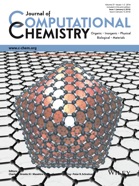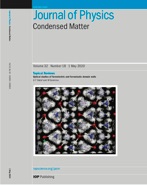
Contact
Office 2604
School of Physics and Astronomy
James Clerk Maxwell Building
Peter Guthrie Tait Road
The University of Edinburgh
Edinburgh, EH9 3FD
Phone +44 131 650 5824
Email a.hermann@ed.ac.uk
About Me
I hold the Chair of Computational Physics in the School of Physics and Astronomy at the University of Edinburgh. My research is in the field of computational materials science: using first-principles, parameter-free computing methods to predict and understand properties of materials – such as their stability, elastic, electronic, and optical attributes.
As member of the Centre for Science at Extreme Conditions, a part of my research focuses on the occurrence of new, interesting phases of various materials under conditions of extreme compression and high temperatures.
Join the Group
Students interested to join the group for a PhD are always welcome. Research projects can be found on the School’s web pages, together with information on the application process.
We are always happy to support suitable candidates for postdoctoral fellowship applications.
Potential undergraduate research projects are listed on the School’s wiki page (requires login).
News
10/2025: Close-packed bromine
The halogen elements (group 17) form molecular crystals, but at high pressure the molecules disintegrate. In this atomic regime, halogens are thought to undergo a series of phase transitions, ultimately reaching a close-packed cubic structure. For bromine, we have now studied this phase sequence, which features three kinds of phase transition: from molecular to atomic structure, via an incommensurately modulated intermediate; from orthorhombic to tetragonal, via second order transition regulated by strong lattice anharmonicity; and from tetragonal to cubic close packed, via conventional first order transition. Painstaking calculations by Dominik Kurzydłowski and experiments by Eric Edmund were key to our understanding; results are now published in Phys. Rev. B.
09/2025: Thermodynamics of dense ices
Ice VII is a central phase in water’s phase diagram, characterised by two intercalating disordered body-centered hydrogen bond networks. Upon cooling, ice VII’s water molecules order into ice VIII; upon compression, the hydrogen bond symmetrise into ice X. Led by Graeme Ackland, we have developed a three-state free energy model that describes the physics of the ice VII-VIII-X phase relations, and reproduces the known phase boundaries. The model predicts that the VII-X transition is a supercritical crossover, with a VII-X critical point potentially hidden within the stability region of ice VIII. This work has just been published in Phys. Rev. B.
09/2025: Potassium superhydrides
Alkali metal polyhydrides were amongst the first predicted high-pressure superhydrides, but took a long time to be synthesised. Potassium hydrides are the final piece of this puzzle, and in work led by the Peña Alvarez’ group, we now report the high-pressure formation of two different KH9 compounds, the first of which forms below 20 GPa at room temperature. The compounds align with a previously predicted KH9 structure, and a previously observed RbH9 structure. Our calculations confirmed the composition, structural, and spectroscopic properties. This has just been published in J. Phys. Chem. Lett.
09/2025: Izzy joins the group
Izzy Rodger joins the group as new doctoral student. Izzy will work on developing machine-learned interatomic potentials for direct simulations of dynamic compression processes, in a jointly supervised project with Graeme Ackland – welcome to the group, Izzy!
06/2025: Machine learned interatomic potentials code
Tadah, a versatile and agile software package to generate and use machine learned interatomic potentials has been published – see here for documentation and to download the code, and here for the paper describing its features: including a wide range of atomic descriptors, regression methods, and a unique hyperparameter optimisation scheme to enable models that optimise performance, matching computational training data, or experimental observables.
02/2025: Reactions of methane and nitrogen
Methane, CH4, and nitrogen, N2, are two of the most inert molecules. What happens if they are put together and forced (via application of pressure) to interact? As it turns out, two stoichiometric van der Waals compounds form, and remain stable up to very high pressures. Chemical reactions between them can be induced by either pressure (in the megabar regime), or temperature (by laser heating). Calculations are crucial to establish compounds’ compositions, properties, and potential reaction products. This collaborative work, spearheaded by experiments from the Howie group, have just been published in Angewandte Chemie.
01/2025: Bole joins the group
Dr Bole Chen of Chongqing University joins the group as a Global Talent research visitor, funded by the China Scholarship Council. Bole will contribute to various ongoing projects in the group over a period of two years – welcome back to the group, Bole!
01/2025: Milo joins the group
Milo Dixon joins the group as new doctoral student. Milo will work on ternary superhydrides for superconductor applications, in a jointly supervised project with Miriam Peña-Alvarez – welcome to the group, Milo!
11/2024: New funding from the Royal Society
The group has been awarded a Royal Society Exchange Grant to collaborate with the Hamprecht group at Heidelberg University on developing orbital-free density functional theory methods for crystal structure prediction. The grant will support academic exchange between our groups over the next 24 months.
10/2024: Complex ternary metal hydrides
Transition metals can form complex hydrogen-rich anions MHxn-, supported by alkali counter cations. Very hydrogen-rich stoichiometries can emerge, representing a route to stabilise metal polyhydrides at ambient conditions. Here, in collaboration with the Peña Alvarez group from Edinburgh, we demonstrate the high-pressure synthesis of two new hydrides of this type, NaReH8 and NaWH9, along with a sequence of phase transitions down to near-ambient pressure conditions. Our calculations are crucial to confirm the compositions and structures of these compounds. The results have just been published in Inorg. Chem.
09/2024: Yu Cai joins the group
Yu Cai joins the group as new doctoral student. Yu will work on developing machine-learned interatomic potentials for materials under extreme conditions – welcome to the group, Yu!
09/2024: David joins the group
David Lewis joins the group as new doctoral student. David will work on free energy calculations of planetary ices, in a jointly supervised project with Tetsuya Komabayashi from Edinburgh’s School of GeoSciences – welcome to the group, David!
09/2024: Ammonium fluoride under pressure
Ammonium fluoride, NH4F, is an ionic analogue to ice, forming tetrahedrally bonded network structures. However, pressure will eventually break this analogy: as predicted in a recent paper of ours, NH4F will depart from ice-like phases. The confirmation of this prediction, led by our experimental partners in Paris, Rome, and Lausanne, has just been published in Comms. Chem. X-ray diffraction and Raman spectroscopy data is complemented by our calculations that explore the unusual nature of the high-pressure phase transition.
06/2024: Room-temperature superconductor prediction
The main challenge around hydride superconductors is to lower the required operational pressures while retaining high superconducting transition temperatures. Our latest research, published in Proc. Natl. Acad. Sci., might just set the stage for the next big breakthrough. We predict that a ternary La-Sc-H material can exhibit superconductivity above room temperature at 150 GPa, and reach as high as 58°C under pressures up to 250 GPa.
05/2024: Sarah joins the group
Sarah Alnujaim joins the group as new doctoral student. Sarah will work on strongly correlated heavy fermion materials – welcome to the group, Sarah!


